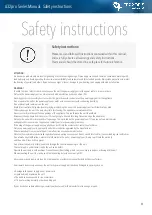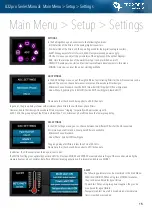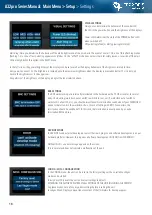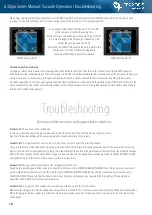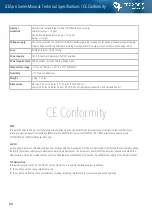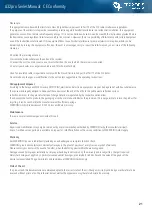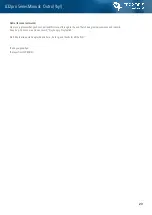
17
A32pro Series Manual: Remote Control / Cascade Operation
Remote Control
Remote control via RemoteFish App (PC / Mac)
The A32pro Dante can be completely remote controlled via the RemoteFish app. The connection can be controlled either via the USB socket (MIDI-
over-USB), MADI (MIDI-over-MADI), the MIDI I/O ports of the unit (via a separate MIDI interface) or via Dante* (Remote-over- Dante). In principle,
all functions that can be controlled via the front panel can also be controlled via the RemoteFish app.
(* A32pro Dante only)
For some applications, the 32x32 channels may not be sufficient. Likewise, both Dante and MADI offer a channel count of 64x64 channels
per cable at single sample rates (SMUX/1). To "fill" this channel count completely, several A32pro (Dante) units can be cascaded.
In the MADI network, this is done by daisy-chaining or, in rare cases, in star topology. In the Dante network, star cabling is used as standard
to connect to an Ethernet network switch.
Cascade operation via MADI
Equipping the unit with a maximum of two SFP modules results in a wide range of possible application scenarios. A MADI connection offers
64 channels in each direction at a sample rate of up to 48 kHz (SMUX/1 operation). Due to a limited bandwidth, the number of channels is
halved with SMUX/2 (64 to 96kHz), as two channels are bundled to transmit a 96kHz channel. This is called multiplexing. With SMUX/4 (128
to 192kHz) four channels are multiplexed to transmit one 192kHz channel, reducing the number of channels to 16x16. Generally possible
with MADI is cabling in star topology as well as in series (daisy-chain). Which type of cabling makes sense depends on the respective
application. For a star topology, the other device must have several MADI I/O ports. This would make sense, for example, if you were
recording at 192kHz, because then all available channels (16x16) of a MADI I/O port would be occupied. So when using two A32pro
units at 192kHz, you need another MADI device (e.g. MADI Audio Interface) with two MADI I/O ports.
Wiring in series (daisy-chain) therefore only makes sense with sample rates in SMUX/1 mode (up to 48kHz), where you can use the
remaining free channels for the next unit(s) in the chain. When MADI is wired in series at up to 48kHz (SMUX/1), a maximum of two
A32pro units can be connected in series. At higher sample rates daisy-chaining is no longer possible due to the limited bandwidth of the
MADI format. As the A32pro Dante has two SFP slots (so-called cages), the MADI data stream can be distributed over two ports.
This can be interesting for redundancy purposes as well as for scenarios with extended routing.
The A32pro series can be remotely controlled in several ways:
Remote control via MIDI CC
As an alternative to operation via the front panel or the RemoteFish app, the unit can be controlled via simple MIDI CC. Remote control can be
done via USB (MIDI-over-USB), MADI (MADI-over-USB) or the MIDI I/O ports of the unit.
The assignment of the MIDI messages to the most important control parameters of the A32pro Dante can be found in the appendix.
Cascade Operation
Cascading multiple A32pro (Dante) units

